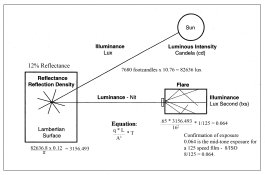Bill Burk
Subscriber
- Joined
- Feb 9, 2010
- Messages
- 9,432
- Format
- 4x5 Format
Got my answer. We can trust the meter and chart...
Wikipedia article on EV shows that the chart includes C just like we have to include the 100... So the chart is correct for incident meters with 100 speed and C is 250:
EV[100][C=250]
The charts are correct, and just as they are incomplete without the film speed assumption [100], they are incomplete without the C assumption [250].
So knowing both speed 100 and C 250, EV 0 is 2.5 lux.
Probably would be difficult - I won't propose to do that since I have an incident meter.
But then incident meter applies C to give the film plane exposure recommendation.
When using an incident exposure meter to try to evaluate incident light... Do published charts that convert EV[100] to incident light values... back out C? If they back out C I think they would have a better chance of correctly telling how much light is falling on the scene.
Wikipedia article on EV shows that the chart includes C just like we have to include the 100... So the chart is correct for incident meters with 100 speed and C is 250:
EV[100][C=250]
Or is EV[100] a film plane exposure that incorporates C... making those published charts slightly wrong?
The charts are correct, and just as they are incomplete without the film speed assumption [100], they are incomplete without the C assumption [250].
So knowing both speed 100 and C 250, EV 0 is 2.5 lux.






